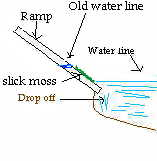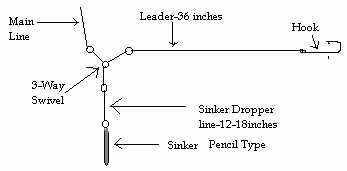" Fishing Dam Tail-waters "

Safety
Fishing dam tailwaters can be both exciting and challenging. The striped bass fisherman must be aware of the dangers and hazards when boating in these sometimes turbulent waters. Think safety first because water conditions change rapidly and accidents can occur quickly.
The launch ramps in rivers must be used with caution.
Water levels at launch ramps below dams can change drastically in a short period of time.
Ramp Diagram
 When water drops quickly it exposes moss and slime on ramps that is extremely slippery and dangerous to walk on.
When water drops quickly it exposes moss and slime on ramps that is extremely slippery and dangerous to walk on.
Current washing away at the ends of ramps create a steep drop off. When water levels are low, launch slowly and carefully because it is easy to drop the trailer axle off the end of ramp.
Underwater hazards are not usually marked in rivers, as they are in lakes. It is a good idea before fishing in new tailwaters to ask questions at local baitshops and of fisherman you meet at launch ramps. Underwater objects cause ripples and riffles on water surface so be alert for these and go slowly around any you observe. Dam overflows, gate openings, and turbine releases cause backflows that will pull you into them so "keep your distance". You are responsible for your own wake which will be larger due to the boat pushing upstream into current. So be aware of the effects of your wake on other boats and any bank fisherman.
Baitfish
The key to catching striped bass in tailwaters is baitfish, locating, catching, keeping, and presenting the baitfish. The baitfish hold in ribbons of current and eddies where it is easier to swim and plankton is brought to them by the current. The ribbons are caused by water currents running into each other or into a solid object. Eddies are caused by an object breaking the current flow. I will show in the tailwater diagram below where these slack water ribbons and eddies are located. The three types of baitfish primarily used here in western Kentucky are gizzard shad, threadfin shad, and skipjack herring. Keeping the baitfish fresh and lively is the key to catching more fish. Presenting the baitfish will be covered in the following sections on methods of fishing tailwaters.
Bottom Bumping
This method is done by using a 3-way rig and fishing as vertical as possible.
I use a 3oz. pencil type sinker the majority of the time for this method, weight size is determined by drift speed and current flow.

The rod should be held in a horizontal position. Drop the baited 3-way rig straight down. The rig will drop at a rate of about two feet per second. Release the reel spool holding the spool from turning with your thumb. Release your thumb from the spool and count down as the bait is dropped until you feel you are near the bottom. Example: thousand one, thousand two, thousand three, till you get to 15 if water is 30ft. deep. Stop the spool with your thumb and lower the rod tip slowly three to four inches to make bottom contact. If the bottom is not felt release thumb from the spool and count another two seconds stopping the spool again and feeling for the bottom. Continue this until you find the bottom. When the bottom is found turn the reel handle to engage the reel, then lift the rod tip two to four inches until you feel the the sinker come off the bottom. Then lower the rod tip till the bottom is felt again. Continue this slow lift and drop as you continue your downstream drift. If you do not feel the sinker come off the bottom reel up two turns of the reel handle, lower the rod tip again and feel for the bottom. Watching the rod tip will also help you know if the sinker is making bottom contact. If the bottom is not felt when you lower the rod tip, release the spool for a two second count, stop the spool with your thumb and feel for the bottom again by lowering the rod tip. When the bottom is found engage the reel and lift again raising the bait just slightly off the bottom. Continue this lifting and dropping throughout the drift making adjustments in reeling up and releasing line as you make occasional bottom contact. Do not drag the sinker on the bottom.
Swimming The Bait
This method is used if you think the fish may be suspended off the bottom. Use the 3-way rig as in the bottom bumping method but go to a lighter sinker. You will know when the sinker is the right weight when the slightest lift of the rod tip will enable the bait to swim the sinker. Instead of dropping straight down the bait should be cast up and across stream at a 45 degree angle. The rod tip should be held at about the ten o'clock position and the lifts and drops should be longer, a slow pumping motion of about two feet of rod tip movement. Varying the length of time the rod tip is held at the top of the lift and varying the time the sinker is allowed to touch bottom when the rod tip is lowered.
Drifting
The best way to catch striped bass in tailwaters is by drifting. The slack water ribbons, baitfish, and striped bass are constantly shifting. Drifting allows the fisherman to cover more water and make adjustments to these changing conditions. The drift pattern should be made in a D shape. Start by drifting the ribbon of current that will cross the most bottom changes. Returning back upstream in a looping fashion as shown in tailwater diagram below. This loop back upstream should be made over an area that is least likely to hold baitfish or stripers. If you return upstream over your bait and fish you will scatter both and ruin your own fishing. Drift both sides of the ribbon of current next. If you have not caught a fish or had any bites move to the next ribbon of current and drift it and both sides. Continue checking all ribbons till you find the fish. Start with the bottom bumping method covering all ribbons. If you have not had any success change to the swimming method and cover all ribbons again. Drift speed is normally best when you drift as close to the same speed as the river current, as possible. A drift with the boat positioned sideways to the current will make the boat drift faster. Drifting straight with the current will slow your drift. Sometimes you will need the electric or outboard motor to get the proper drift speed. If it is safe to do so, do not leave the outboard motor running because this will scatter the bait and in turn the fish. Be sure to keep a constant check behind you as you drift because unobserved barges or boats can move into your drift path.
